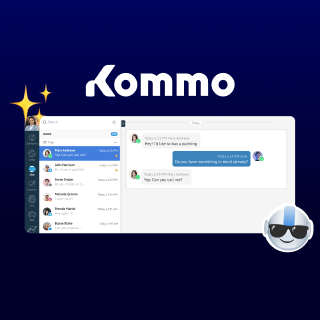Expand Your Capabilities
We aim to offer a wide range of possibilities for integrating Kommo with various services and systems. This allows our customers and partners to expand Kommo’s functionality for themselves and others.
Developing your own widgets and integrations is not as difficult as it may seem at first glance. To facilitate the task for developers, we provide instructions, recipes, and descriptions.
What is Integration?
Integration refers to any interaction with a third-party service, while an individual or team responsible for creating an integration is called an integrator.
An integration is a database record that identifies an external application interacting with Kommo. To access Kommo user data, developers must create an integration (enter the name and the description of the service, add a logo). Upon creation, Kommo provides the keys required to access our API.
Integrations include
- a set of secret keys for OAuth2 authorization (client_id, client_secret, authorization_code)
- metadata such as the name, logo, and description. This information is necessary for users to know which service has access to their account and data.
- a widget archive containing JS code executed in the Kommo interface is also included, but not required.
There are two types of integrations that we highlight:
Personal integration
This is the simplest type of integration, where we create an integration to provide additional features within a single Kommo account.
For instance, a developer/partner may create a unique feature that only one company/account needs, such as a webform on a website or an integration with unique client software. Integrations of this type do not require moderation and will not be published in the Kommo marketplace.
To create an integration, follow these steps:
- Log in as an account administrator.
- Go to Settings -> Integrations, click the Create integration button and submit the simple form.
- Copy the secret keys, authorize using them, and start exchanging data.
The following method allows the usage of the Button on site, however, the list of the available accounts will be limited to only one account where the integration is created.
Private integrations can include a widget that works within the Kommo interface, but only in the account where the integration was created.
Marketplace integration
If you are developing an integration that could be useful for all Kommo users, we would be glad to publish it on our marketplace. However, integrations of this type must pass our moderation process. This involves testing and auditing the JavaScript code to ensure the security and quality of the user experience.
As developing such integrations is a more complex process, we provide separate technical accounts for integrators of marketplace integrations where they can communicate with our support and testing team. In the technical account, the integrators can also work with an advanced interface for custom integrations, which includes features like integration versioning and support for multiple languages.
Marketplace integrations can include widgets that work within the Kommo interface. These integrations can be installed from an external website using the Button on the site mechanism.
Integrations can help you:
- Display your layout in allowed system locations such as lead or contact cards, lists, pipelines, dashboard, etc. You can also add an interface for users to interact with the integration.
- Affect the display and behavior of standard Kommo interfaces.
- Exchange data with external systems by sending requests or with Kommo via the REST API.
- Receive data from the page context and JS objects initiated by Kommo.
Learn more about integrations development.
Here are some integrations use cases:
- Display additional information about a contact from your internal accounting system in the contact card.
- Allow your company’s employees to send a request to the accounting department to form a payment directly from the lead card.
- If you are the developer of a third-party service (such as messenger, VoIP or email server), you can give Kommo clients the opportunity to use your service by publishing a marketplace integration and making it more transparent and easy.
Instruments
In addition to the ability to receive, add, and update data in Kommo using REST API, and utilizing the Integrations system described above, we provide an additional set of instruments for creating a convenient and easy-to-use integration with Kommo.
SalesBot is a tool for creating custom scenarios for automated operations with users via messengers. Kommo has several default messenger integrations, including Facebook Messenger, Telegram, Viber, Skype, and others. We provide a custom SalesBot language and visual editor to create automated scenarios for communicating with users. Additionally, Integrators have the option to embed their integration into the Bot workflow.
Digital Pipeline is a powerful automation tool that comes with its own constructor. The constructor enables you to set up automatic system reactions for events such as lead status changes and website visits. Kommo can react with a wide range of customizable actions, such as setting up a task, adding a contact or sending an email. Additionally, Integrators can create their own event handlers and add them to the list of available automatic actions.
Lists are custom data tables that can be created via API or the Kommo interface. Users can access these tables via standard interfaces, and integration can manage data via API. If necessary, users’ rights to edit this data via standard interfaces can be restricted. Examples of such lists include product lists, invoice lists, and order lists. These tables have fields that are managed by integration but can be linked to the main Kommo entities (leads and customers).
Webhooks allow users to subscribe to certain events (such as a contact change or a new task) in Kommo, either manually or via API. When such an event occurs, the corresponding script is launched and the user receives an entry context of the event. This instrument enables users to track necessary data changes, without depending on periodic synchronization but going off of the event model.
VoIP API is a set of JavaScript methods and libraries, like call record players, push notifications and others, as well as specific API and usage examples. It is useful for integrators developing integration with telephony services.
Chats API is super useful and comprehensive for any integrator tasked with connecting a new message source, such as a new messenger. For instance, you can develop your own integration with WhatsApp using our API and distribute it on your own terms. In this case, you will be responsible for transferring messages and controlling the WhatsApp API. To end-users, this will appear as if they are sending messages directly to the messenger and receiving them in Kommo. SalesBot is also compatible with incoming messages from your source.
Notification Center is the Kommo notification system which is similar to push-notifications on mobile devices. Message delivery is implemented via web-sockets. Users can view the history of notifications and configure message delivery settings. The Notification Center API is also open to use.


